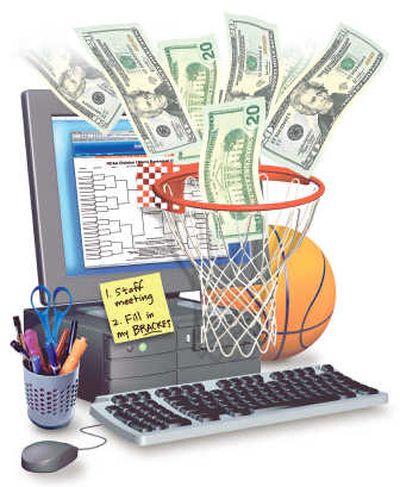NCAA tournament goes to Web video

In terms of audience size and fan enthusiasm on the Web, the next few weeks of college basketball will set the standard for online involvement. Starting Thursday, the annual March Madness of NCAA men’s college basketball takes over the Internet in a way nothing else has.
For millions of fans, the event is purely a TV experience.
But as more people gain broadband Internet service in their homes and offices, the tourney has evolved a second life on the Web, with sports links and fan features providing more ways for enthusiasts to participate.
In addition to now giving fans every game via Web video, the Web is used by companies across the country to set up online office pools. In addition, popular social sites such as Facebook have created March Madness applications so that members can talk smack, compare predictions, share highlight video and razz others about teams bowing out early.
CBSSportsline, which owns the TV rights to the men’s games, doesn’t predict the number of people who’ll use the online streaming video player this year. That player can be found at mmod.ncaa.com.
Five years ago, when CBSSportsline started streaming the games on the Web, it was an experiment. The first year, viewers had to pay for the games; the second year and ever since, the streaming games are free to watch.
Last year all but the final four games and championship were streamed. This year every men’s game will be streamed via the Web; in addition, CBSSportsline no longer blacks out streaming of a game that is also being broadcast live in a viewer’s TV market. CBSSportsline spokesman Alex Riethmiller said it has concluded the Web doesn’t cut into the TV audience and vice versa. The two coexist and boost the total tournament experience, he said.
No registration will be required to view the streaming games this year, but advance “VIP” signup helps give users priority place in line when the site bogs down from heavy use.
Last year CBSSportsline estimated more than 1.3 million people logged onto the streaming videocasts of games during March Madness. Riethmiller said it expects another jump this year, in part because it has expanded ways for people to log on and stream the games.
Users of popular video streaming site Joost, for example, will have the option of watching the games through its player for the first time.
“It will be in the millions, that’s all we can be sure about,” Riethmiller said of the audience this year.
With millions of people logging on, the technical challenge becomes one of managing the user connections so that the video quality remains above-average.
To optimize the video stream, CBSSportsline has turned to content-management company Akamai, Riethmiller said.
Akamai has 30,000 servers around the world, most of them coupled to the networks of major Internet service providers like Comcast or Verizon.
That equipment helps ensure that wherever a user is, the distance to an Akamai server is relatively close and always the quickest “first hop” as it moves traffic across the Web, according to Akamai’s Tim Napoleon, the company’s chief strategist for media and entertainment.
Working with CBSSportsline, Akamai is able to cache, or store, the NCAA video streams at most of its 30,000 servers. When March Madness fans start watching one of the games, the short distance from a computer to the server makes downloads faster and video streams more consistent, Napoleon said.